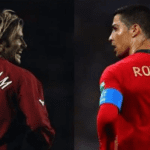Understanding the Six Soccer Defensive Positions
- Last Updated -
Soccer is a game that requires a lot of teamwork, and a critical part of that teamwork is knowing the different positions on the field.
In soccer, there are six different defensive positions – goalkeeper (GK), sweeper (SW), full back (FB), center back (CB), wing back (WB), and holding midfielder or center defensive midfielder (CDM). Each of these positions has specific roles and responsibilities that contribute to a team’s defensive strategy.
Let’s Look At The 6 Soccer Defensive Positions
1. Goalkeeper (GK)
The goalkeeper is the last line of defense in soccer. Their primary role is to prevent the opposing team from scoring by blocking shots, catching crosses, and organizing their defense. GKs also need to have good communication skills as they are responsible for directing their team from the back.

A good goalkeeper needs to have excellent reflexes, agility, and coordination. They also need to have good decision-making skills and be able to read the game well. Some examples of successful goalkeepers include Manuel Neuer, Alisson Becker, and Jan Oblak.
Let’s look at the 6 Soccer Defensive Positions
2. Sweeper (SW)
The sweeper position is not as commonly used as it once was, but it can still be an effective strategy for certain teams. The sweeper is positioned just in front of the goalkeeper but behind the other defenders. The sweeper is based in the center of the field and may cover the entire width of the field throughout a game. The role of the sweeper is to clean up any loose balls that may have passed the other defenders.
A good sweeper needs to have excellent vision, as they are responsible for seeing the entire field and anticipating where the ball may end up. They also need to have good communication skills, as they are responsible for directing the other defenders. Franco Baresi and Franz Beckenbauer are examples of successful sweepers.
3. Full Back (FB)
The full-backs are positioned on either side of the center backs, and their primary role is to defend the flanks and prevent opposing players from crossing the ball into the box. Full-backs also need to be able to provide support to the midfield and attack when needed.
A good full-back needs to be fast, agile, and have good stamina as they need to be able to cover a lot of ground. They also need to be able to read the game well and have good defensive skills. Examples of successful full-backs include Trent Alexander-Arnold, Andy Robertson, and Dani Alves.
4. Center Back (CB)
The center backs are positioned in the center of the defense and are responsible for stopping opposing players from getting into the box. They also need to clear the ball out of danger and provide support to the midfield when needed.

A good center-back needs to be strong, aggressive, and have good aerial skills. They also need to have good communication skills and be able to read the game well. Some examples of successful center-backs include Virgil van Dijk, Sergio Ramos, and Kalidou Koulibaly.
5. Wing Back (WB)
The wing-back position is similar to the full-back position, but the wing-backs are expected to contribute more to the attack. They are positioned further up the field and are responsible for providing crosses and creating chances for their team.
A good wing-back needs to be fast, have good dribbling skills, and be able to cross the ball accurately. They also need to have good defensive skills and be able to track back quickly to defend. Examples of successful wing-backs include Marcelo, Jordi Alba, and Andrew Robertson.
6. Center Defensive Midfielder (CDM)
is an essential position in modern football. The CDM plays a crucial role in both the attacking and defensive phases of play, making them a vital cog in any team’s system. The CDM is responsible for covering the defenders by not allowing the attackers to get past them [8]. They are positioned in front of the center backs and typically play in a midfield trio, sitting between two attacking players and the defensive backline.
The primary role of a CDM is to break up the opposition’s play by intercepting passes and cleaning up loose balls in midfield [2]. They must be physically and mentally strong, with excellent tackling ability and a good reading of the game.
They must be good at passing and have excellent vision to spot the attacking players’ runs [1]. Communication is also vital for a CDM, as they need to communicate with both the defense and the attack [8].
In summary,
the CDM is a key position in modern football, responsible for breaking up the opposition’s play, providing cover to the defense, and starting counter-attacks. They must have excellent tackling ability, good passing, and communication skills, as well as a good reading of the game. The CDM is an essential cog in any team’s system and can be the difference between success and failure on the pitch [1][5].
This article focused on six defensive positions: goalkeeper (GK), sweeper (SW), full back (FB), center back (CB), wing back (WB), and Holding Midfield also known as the Center Defensive Midfielder (CDM). Understanding the different defensive positions is important in soccer as it can help players better understand their role on the field and how they can best contribute to their team’s success.
Mastering Soccer Jargon: A Glossary for Fans and Players
Last Updated on April 12, 2024 by Andy Long Mastering Soccer Jargon:...
Read MoreBest Soccer Cleats For Goalkeepers 2024
Diving right into the heart of the matter, let's explore a question...
Read MoreThe Transformation of German Soccer in the 2000s
Kickoff: A Brief Overview of German Soccer in the 2000s The Dawn...
Read MoreBest Soccer Cleats for Women In 2024: Top 5 Picks
The Best Soccer Cleats for Women in 2023: Top 5 Picks The...
Read MoreThe Historical Dominance of Brazilian Soccer in the World Cup
Introduction: The Beautiful Game's Grandest Stage The World Cup, a grand tournament...
Read More5 Best Soccer Cleats For Strikers in 2024
What are the Best Soccer Cleats for Strikers? The beautiful game of...
Read MoreAn Introduction and History of UEFA Champions League
In terms of prestige, nothing surpasses lifting ‘the cup with big ears’,...
Read MoreThe Golden Era of Italian Soccer in the 1990s
A Glimpse into Italy of the 90s: Culture, Politics, and Soccer As...
Read MoreWhat is a goal kick in soccer? Soccer Law #16
Soccer is governed by a set of rules known as the Laws...
Read MoreConcussion Substitutions in Soccer: evolving concussion protocols
The Growing Concern for Player Safety in Soccer Soccer, a beloved sport...
Read MoreThe Impact of VAR on Modern Soccer: Video Assistant Referee
Traditional Refereeing Methods: Balancing Act on the Pitch In the realm of...
Read MoreThe Changing Role of Inverted Wingers
Definition of 'Inverted Wingers' in soccer An inverted winger, also known as...
Read MoreBest Soccer Cleat Insoles – VKTRY Insoles
Try VKTRY Insoles to Improve Your Athletic Performance Now, let's delve into...
Read MoreThe Changing Role of Wingers in Soccer
The Changing Role of Wingers in Soccer. Soccer has captivated millions around...
Read MoreThe Transformation of Midfielders Roles in Soccer
The Transformation of Midfield Roles in Soccer The Evolution of Soccer Tactics...
Read MoreVersatile Soccer Players: Chameleons of the Pitch
Ah, the beautiful game of soccer! A sport that has captivated millions...
Read MoreThe Changing Role of Strikers in Soccer
The Changing Role of Strikers in Modern Soccer Soccer, known as the...
Read More5 Best Soccer Cleats For Speed In 2024
Our Top 5 Picks for the Best Soccer Cleats for Speed in...
Read MoreBest Soccer Ball For Games in 2024: Top 5 Picks
The Importance of Having a Good Soccer Ball for Training Soccer requires...
Read Moresoccer start and restart of play
Brief Overview: Soccer as a Popular Sport Worldwide Soccer's popularity stems from...
Read MoreSoccer Referee Roles and Responsibilities
The Crucial Role of a Soccer Referee In the vast realm of...
Read MoreDiscover the 5 different types of soccer cleats
Introduction - A brief overview of the importance of choosing the right...
Read MoreSoccer Throw In Rules – Soccer Law #15
Law Number 15 - Throw Ins A throw-in in soccer is granted...
Read MoreSoccer 6-Yard Box: The Penalty Area
What is the 6-Yard Box in Soccer? The 6-Yard Box is an...
Read MoreBest Soccer Ball for Training: Top 5 Picks
The Importance of Having a Good Soccer Ball for Training Soccer requires...
Read MoreSoccer Goal Size and Dimensions
Brief History of Soccer Soccer has been played in various forms throughout...
Read MoreDo Grip Socks Help In Soccer?
Do Grip Socks Help In Soccer? The Importance of Footwear in Soccer...
Read MoreCan Indoor Soccer Shoes Be Used on Turf?
Introduction: Demystifying a Controversial Issue Soccer is a sport that requires specific...
Read MoreBest Soccer Cleats For Midfielders 2024
The Best Soccer Cleats For Midfielders in 2023 - Our Top 5...
Read MoreSoccer Positions For Slower Players
Soccer is a unique sport that requires a combination of physical strength...
Read MoreHow to Clean Soccer Cleats Like a Pro
The Importance of Cleaning Soccer Cleats Playing soccer is a great way...
Read MoreNutmeg in Soccer, Soccer’s Sneakiest Move
Soccer is an incredible sport with numerous skills and techniques that make...
Read MoreWhat is a Set Piece in Soccer?
What is a set piece in soccer? Introduction Soccer is a sport...
Read MoreBest Laceless Soccer Cleats 2024
What Are The Best Laceless Soccer Cleats? Soccer players know the importance...
Read MoreWhat is a soccer tackle?
The Importance Of Mastering Tackling Skills For Success In Soccer To succeed...
Read MoreHow To Break In Soccer Cleats
How to break in soccer cleats The Importance of Breaking in Soccer...
Read More


































